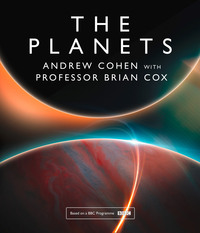
The Planets
‘We couldn’t quite believe it, in fact we thought the data was wrong … we spent over two months looking at and double-checking the information but it was correct, Messenger had found a high level of volatiles such as sulphur, sodium and potassium on the surface.’
Nancy Chabot, planetary scientist, Messenger mission
Right up until the end of its mission in 2015, Messenger continued to uncover many of Mercury’s secrets, including a few very particular surprises. Using a combination of photography, spectroscopy and laser topography, Messenger revealed tantalising evidence that even this close to the Sun, water ice can exist on the surface of a planet. Even though the Sun blasts much of Mercury’s surface, the tilt of its rotational axis is almost zero, so there are craters and features around the planet’s poles that never see direct sunlight. Combined with the lack of atmosphere, these regions are forever exposed to the freezing temperatures of space, and it’s in this environment that Messenger was able to record the clear signature of water ice. Here, in the eternal night of a polar crater, it’s cold enough for ice to survive for millions of years, just metres away from the savage ferocity of the Sun’s light.
However, Messenger’s most startling discovery was still to come. The mission objectives had been developed to explore the deep history of Mercury and provide data to test against our theories of the formation and early life of the planet. Messenger was equipped with a collection of spectrometers designed to analyse the composition of Mercury at different depths. The Messenger team had worked on a detailed set of predictions outlining the chemistry of the planet, but as the spacecraft began to sniff at the Mercurian surface it soon became clear that our assumptions had not been quite right.
As the gamma-ray and X-ray spectrometers analysed the elements on Mercury’s surface they began to measure the unexpected characteristic signature of a number of elements such as phosphorus, potassium and sulphur at much higher levels than they were expecting. Up to this point, the working hypothesis had been that during the formation of Mercury (and all the rocky planets), as the rock condensed and combined to form the planet, the heavier elements like iron would sink towards the centre, forming the bulk of the core, while the lighter elements, such as phosphorus and sulphur, would remain near the surface. These more volatile elements would then be expected to be stripped away from the surface, particularly on a planet like Mercury, which is so close to the Sun. And yet the Messenger data confirmed high levels of potassium, and sulphur was detected at ten times the abundance of the element on Earth or the Moon. Both are volatile elements, easily vaporised, and when this close to the Sun, they simply should not have survived the planet’s birth.
On top of that, the Messenger data confirmed what we had long suspected about the structure of Mercury, that it is the densest of all the planets, with a massive iron core making up 75 per cent of the planet’s radius compared to just over 50 per cent here on Earth. The core creates a strange lopsided magnetic field, indicating that the internal dynamics of the planet are different to anything we have seen before.
All of this adds up to making Mercury something of a mystery, as nothing quite accords. The eccentric orbit, the abundance of volatile elements on the surface and the oversized iron core all point to the planet having a history far more complex than was first imagined, and the best explanation we have to make sense of the Messenger data is that Mercury was not born in its current sun-scorched position. It has long been supposedly known that the orbits of the planets are eternal, stable loops that sustain the structure of the Solar System in an endless rhythm, but everything we are learning now suggests that this is far from the whole story.
MEASURING MERCURY
Messenger was equipped with seven scientific instruments to collect data, including the Mercury Dual Imaging System (MDIS), Gamma-Ray and Neutron Spectrometer (GRNS), X-Ray Spectrometer (XRS), Magnetometer (MAG), Mercury Laser Altimeter (MLA), Mercury Atmospheric and Surface Composition Spectrometer (MASCS) and Energetic Particle and Plasma Spectrometer (EPPS). All these instruments communicated with the spacecraft through Data Processing Units (DPUs) and had to be mounted on the spacecraft with a view of Mercury but without interference from the Sun. They were designed to withstand the extreme temperatures the craft would encounter.
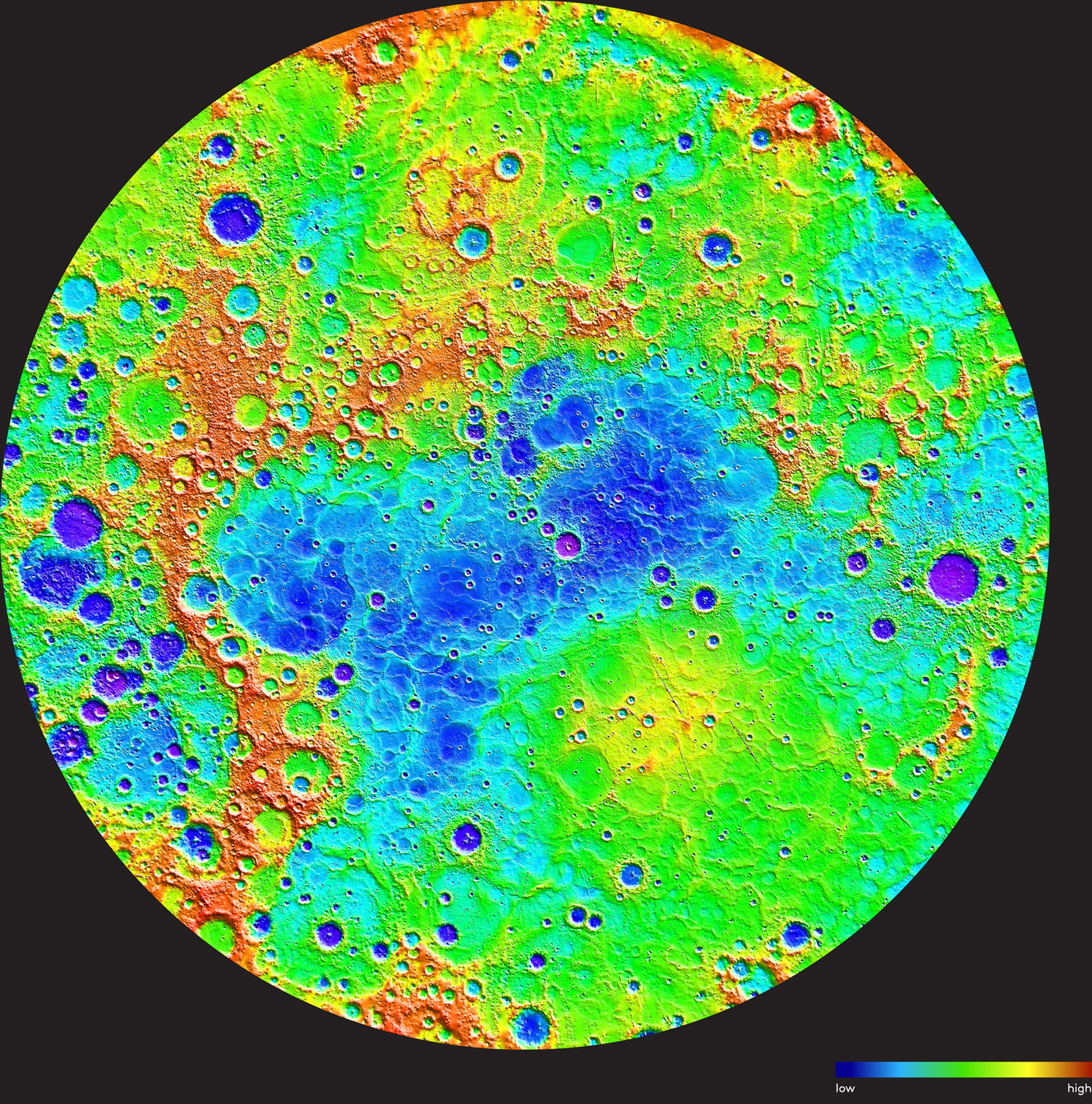
© NASA/Johns Hopkins University Applied Physics Laboratory/Carnegie Institution of Washington
Topography
Messenger’s MLA equipment was able to measure the difference in elevation across the northern hemisphere of Mercury, revealing it to be 10 kilometres between the lowest and highest regions.
Temperature
Messenger recorded expected information about the temperature of the planet, that the craters which were sunlit reached high temperatures, reflected in the red colouration of these images.
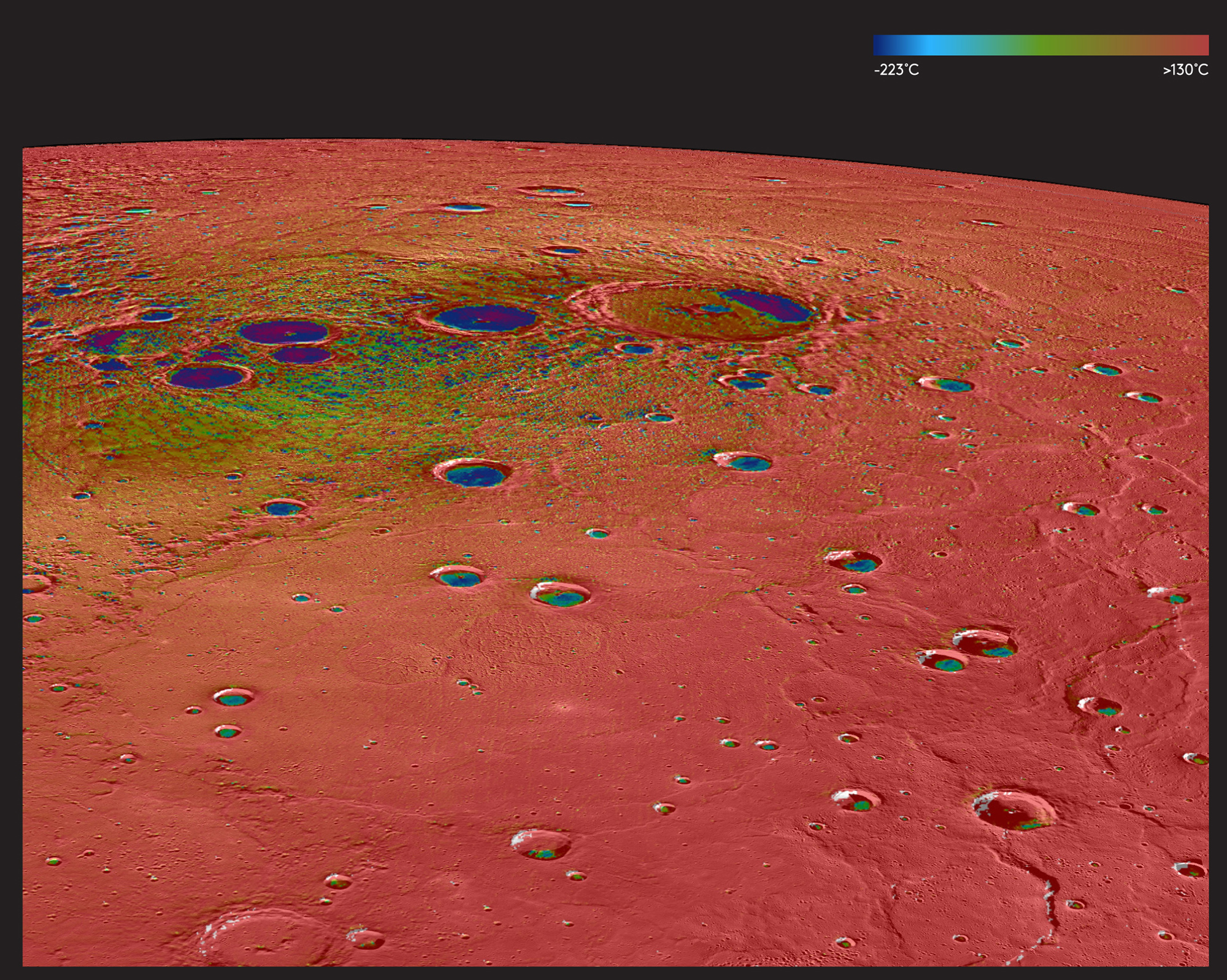
© NASA/Johns Hopkins University Applied Physics Laboratory/Carnegie Institution of Washington
Geology
In this enhanced colour mosaic, the smooth volcanic plains of the Caloris basin are coloured yellow, with the craters picked out in blue.
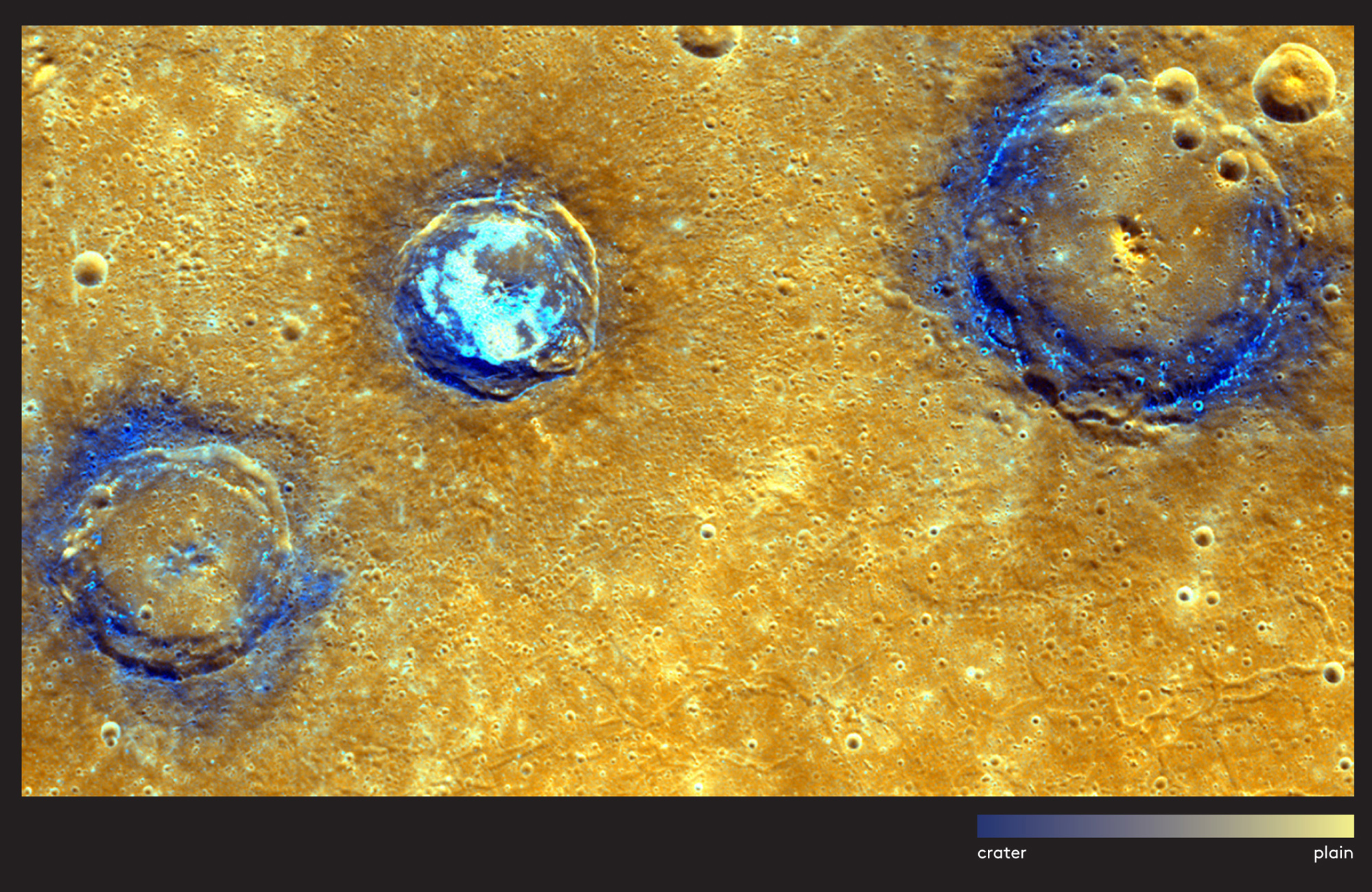
© NASA/Johns Hopkins University Applied Physics Laboratory/Carnegie Institution of Washington
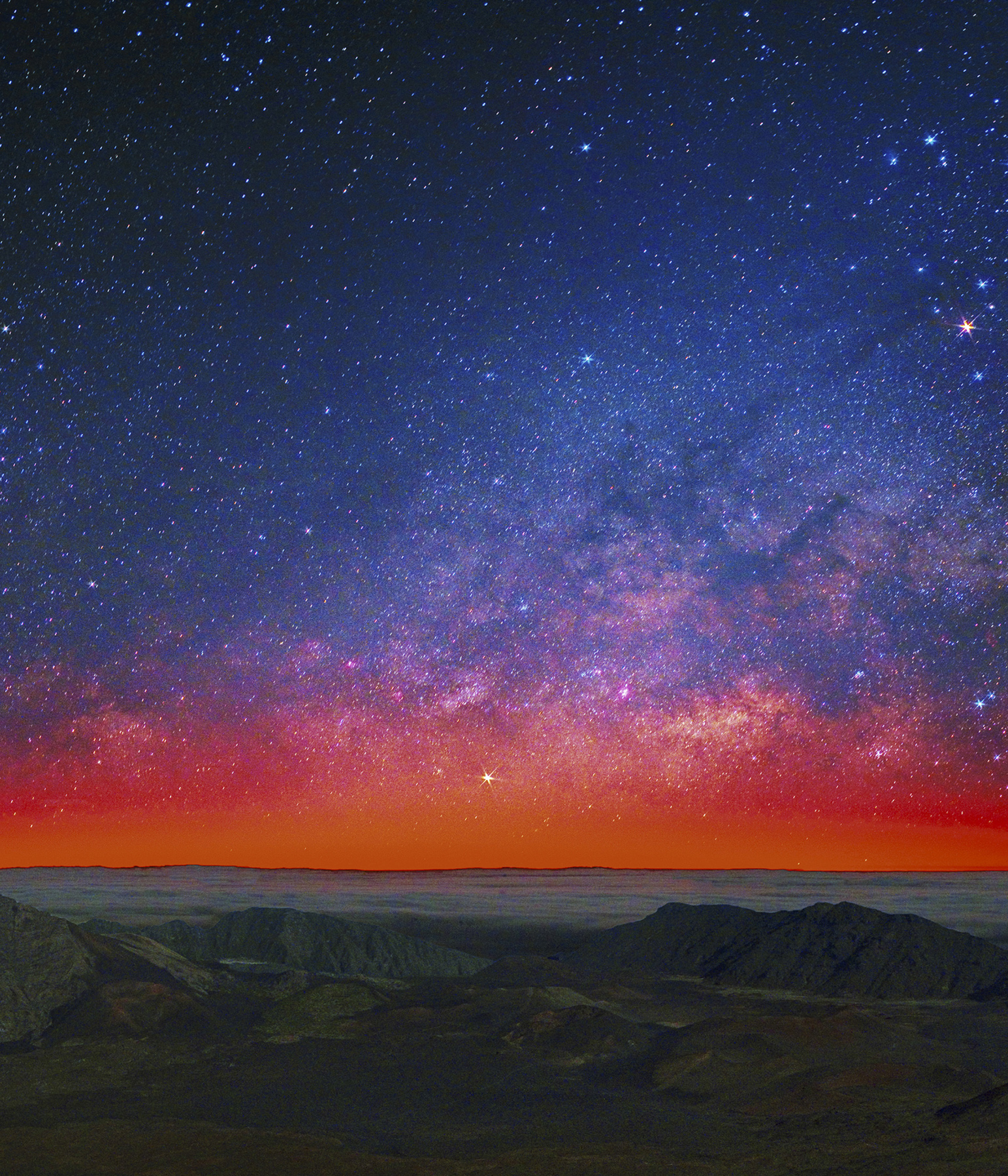
© WALTER PACHOLKA, ASTROPICS / SCIENCE PHOTO LIBRARY
As predictable as the sunrise, Mercury keeps its place in our solar system, visible in the glow of dawn over Haleakala National Park, Hawaii.
A SECRET HISTORY
Mercury, like all four of the rocky siblings, was formed of molten rock. A few million years later, as the young planet began to cool, its crust solidified and its journey around the Sun transformed from being part of a swirling cloud into a clearly defined passage, an orbit. The path the infant Mercury travelled, however, was most probably far removed from the course it now holds. The young Mercury was born not as the closest planet to the Sun but at a much greater distance, far beyond the orbit of Venus, beyond Earth, perhaps even beyond Mars. This was a planet that came into being in the mildest region of the Solar System. It was far enough away from the Sun to allow volatile elements like sulphur, potassium and phosphorus to be folded into its first rocks without being vaporised away by the heat of the Sun, but maybe near enough for its surface to be warmed, perhaps even just the right amount for liquid water to settle on its surface. This may well have been a planet big enough to hold an atmosphere, a watery world upon which all the ingredients of life could well have existed. Mercury, it seems, really did have its own moment in the sun, but these hopeful beginnings were not to last.
Today it’s hard to imagine the planets in any orbit other than our night sky. They feel eternal, permanent, and so it’s natural to think of the Solar System as a piece of celestial clockwork, a mechanism running with perpetual and unchanging precision, marking out the passage of time. In time frames that we can comprehend – days, weeks, months and years – the motion and trajectory of the planets is just that: clockwork. We use these markers to plot out the 24 hours of a day, 365 days of a year, and the lunar cycle is, of course, intimately linked to our months. Beyond that, Newton’s laws of universal gravitation first described in 1687 allow us to this day to plot out the trajectories of all the heavenly bodies far into the future and back into the distant past. This predictability of motion is what allows us to plot great astronomical events, such as eclipses and transits, far into the future. It’s why, for example, we can predict that on 14 September 2099 the Sun, Moon and Earth will be in precise alignment to create the final total solar eclipse of the twenty-first century across North America.
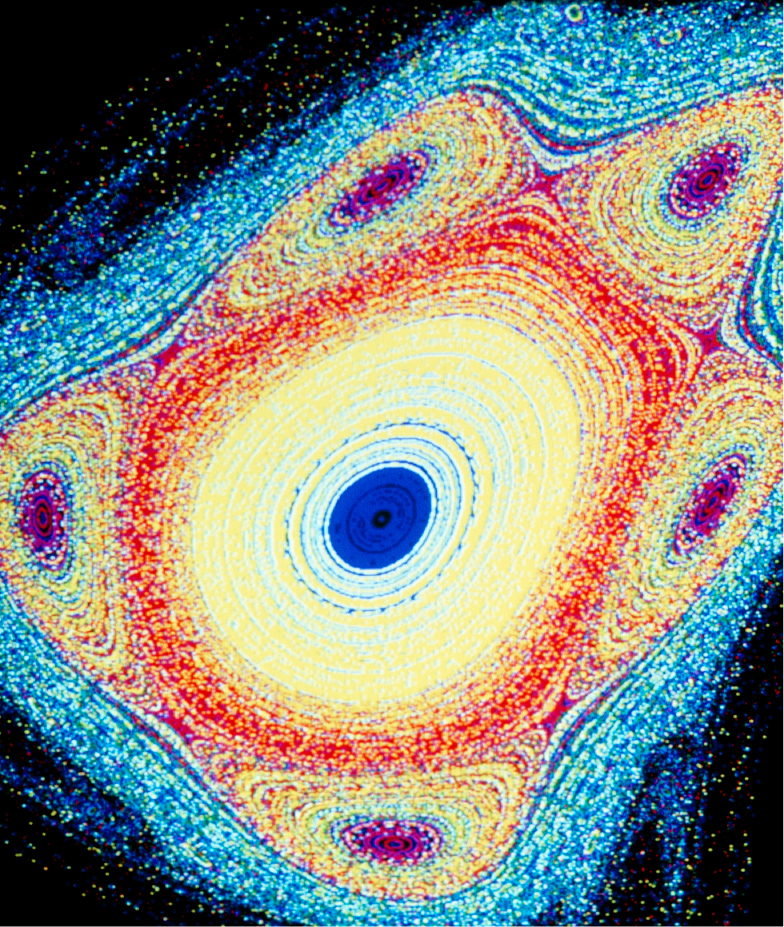
© SCOTT CAMAZINE / SCIENCE PHOTO LIBRARY
Chaos theory is used to predict the development of large-scale events from a given starting point, as shown in this Henon mapping of a chaotic system.
But 100 years ahead or behind us is nothing more than a proverbial blink in terms of the life of the Solar System, and over longer durations the clockwork becomes a lot less reliable. If there was only one planet orbiting one star – for example, if Mercury was the orphan child of the Solar System – we would be able to calculate precisely the gravitational force between Mercury and the Sun, and to plot Mercury’s orbit around the Sun with essentially infinite precision. But add one more planet into our rather vacant imaginary solar system – let’s say we make it Jupiter – so there is now a gravitational force between all three objects – the Sun, Mercury and Jupiter – and it’s no longer possible to calculate exactly where they’re all going to be in the future or where they were at some point in the past.
‘One possible theory is that Mercury didn’t form where it is today, but much closer to the other planets, maybe even outside of Venus, or Earth, or somewhere in between. Then because of interactions with Jupiter, Earth, Venus, and so on, it got put into a chaotic path that pushed it farther into the Sun.’
Larry Nittler, cosmochemist, Messenger mission
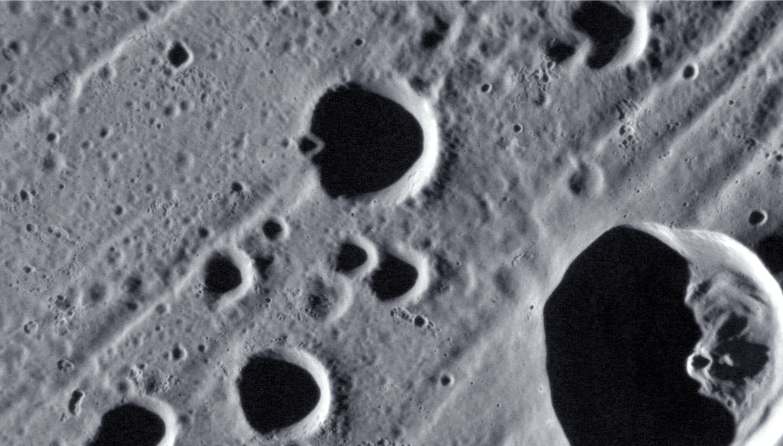
© NASA/Johns Hopkins University Applied Physics Laboratory/Carnegie Institution of Washington
The incredible shrinking planet
The surface of Mercury is made up of just one continental plate covering the entire planet. Over the billions of years since its formation at the birth of the Solar System, the planet has slowly cooled, a process all planets undergo if they lack an internal source of heat renewal. As the liquid iron core solidifies, it cools, and the overall volume of Mercury shrinks.
When NASA’s Mariner 10 mission circled the planet in the 1970s, it captured images of surface features created by the shrinkage. The contracting planet pushed the crust up and over itself, forming scarps that can extend miles below the planet’s surface. At the same time, the shrinking surface caused the crust to wrinkle up on itself, forming so-called ‘wrinkle ridges’.
The scarps and wrinkle ridges identified by Mariner 10 allowed scientists to estimate that the planet had lost approximately 1 to 2 kilometres in global radius, a finding that contrasted with their understanding of the heat loss the planet suffered over time.
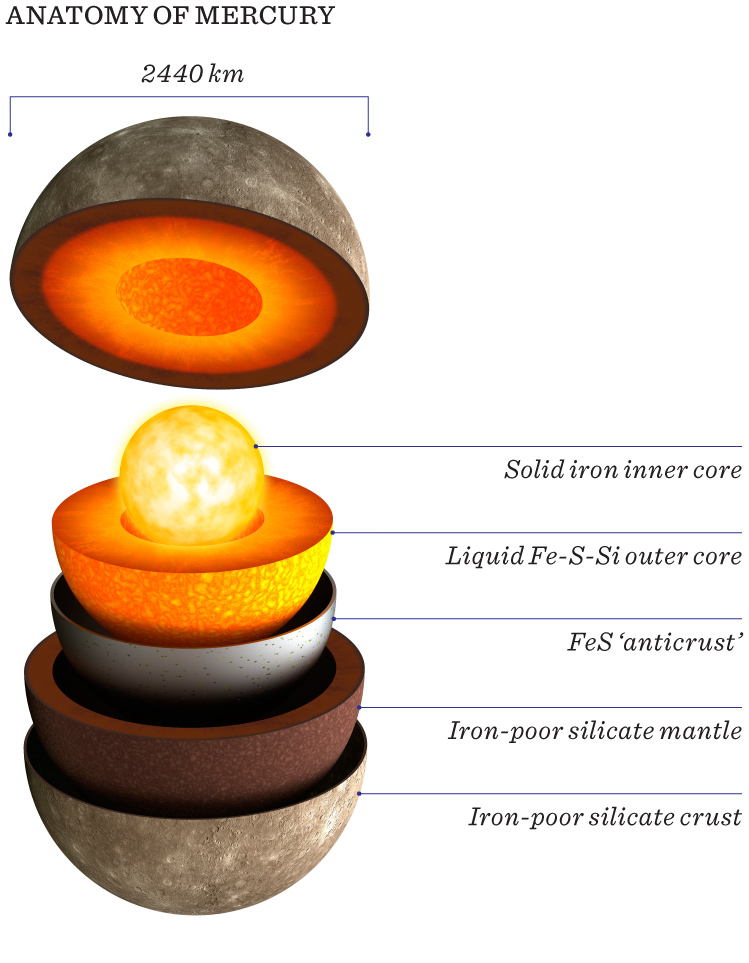
© MARK GARLICK / SCIENCE PHOTO LIBRARY
When there are more than two objects in play at any one time you have what physicists call a chaotic system. It means the planets can push and pull one another, moving entire orbits in ways we simply cannot predict. So the further we look back in time, the less certain we are of the position of any of the planets. Our mathematics fails, so instead we have to rely on circumstantial evidence to piece together a picture of the past. In the case of Mercury, it’s the evidence from Messenger detailing the levels of volatile elements like potassium and sulphur that enable us to begin to understand the early life of the planet and infer that Mercury must have begun life further out in the Solar System than it finds itself today. So what happened next? How did a planet that began its life in the sweet spot of the Solar System end up in the scorched interior?
The answer lies in the other clue Messenger confirmed for us – Mercury’s massive iron core. Relative to its size, Mercury has the most massive core of any of the rocky planets: 75 per cent of its diameter and almost half of its mass is molten iron, compared to around just a fifth of the mass of the Earth. We’ve suspected the oddity of Mercury’s composition for well over 150 years, and that’s because of some brilliant deduction by a German astronomer called Johann Franz Encke, who determined the mass of Mercury by measuring the gravitational effect it had on a passing comet, a comet that we now call, unsurprisingly, Comet Encke. With an approximation of the planet’s mass we are able to calculate the density of the planet, and with that calculation approximate its composition.
So we’ve known for some time that Mercury is odd, but only with the arrival of Messenger did we begin to reveal just how odd the smallest planet actually is. By accurately measuring Mercury’s magnetic field we’ve been able to confirm that far from being a geologically dead planet, Mercury has a dynamic magnetic field driven by an internal force, indicating that the core is at least partially liquid. This goes against the conventional thinking of planetary dynamics because we would expect a planet as small as Mercury to have lost its internal heat long ago. Just as Mars lost its heat because of its size (a story we will come to in the next chapter), we would have expected the core of Mercury to have cooled and solidified.
But Messenger’s data proved otherwise. By combining precise measurements of Mercury’s gravity field with the extraordinary mapping of its surface, Messenger found that Mercury’s structure is unique in the Solar System. It appears to have a solid silicate crust and mantle above a solid layer of iron sulphide, which surrounds a deeper liquid core layer, possibly with a solid inner core at the centre of the planet. This challenges all the theories about its formation.
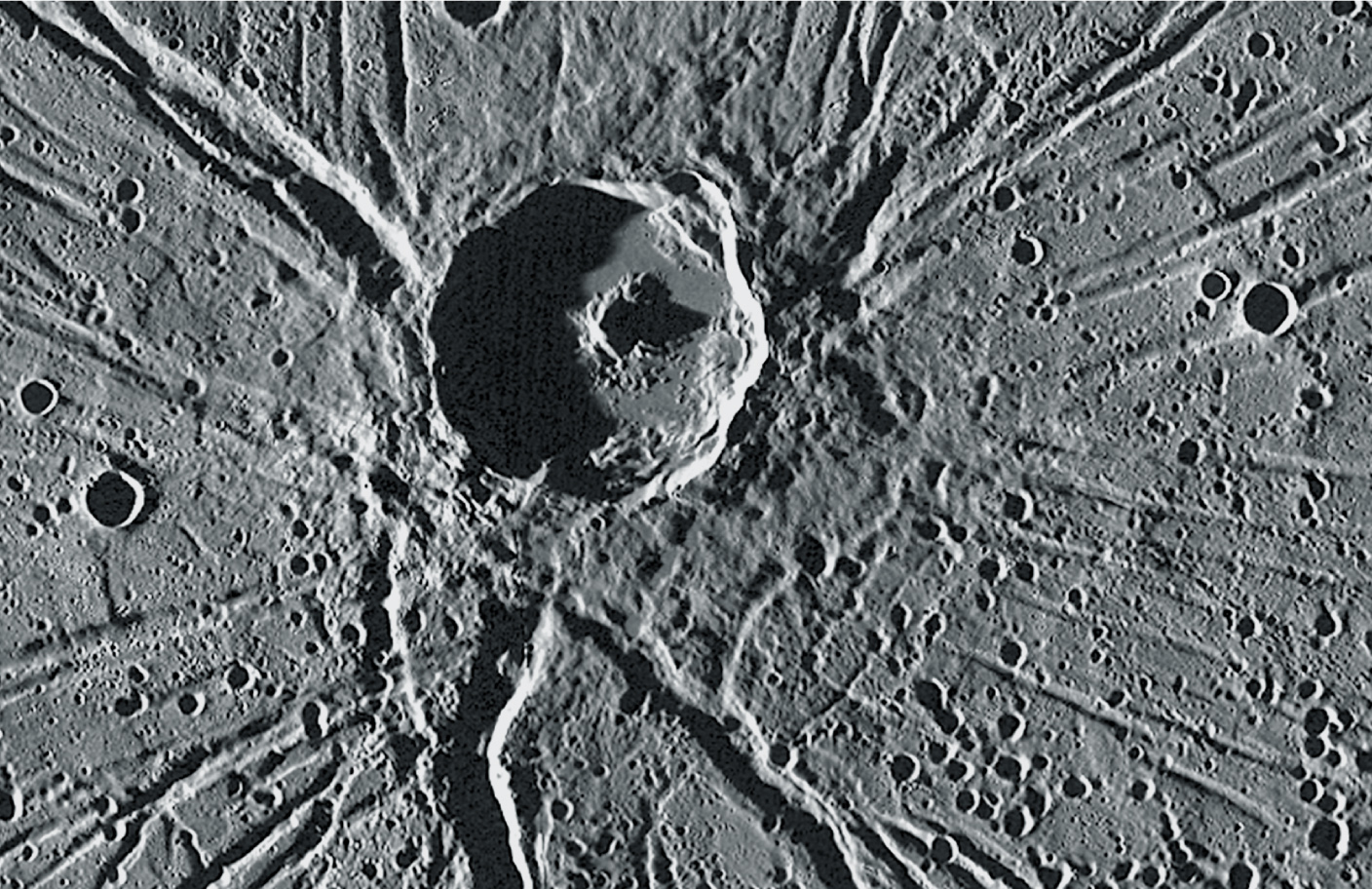
© NASA/Johns Hopkins University Applied Physics Laboratory/Carnegie Institution of Washington
Messenger captured this image of Apollodorus crater, near the Caloris basin; the radiating troughs led scientists to give it the nickname ‘the spider’.
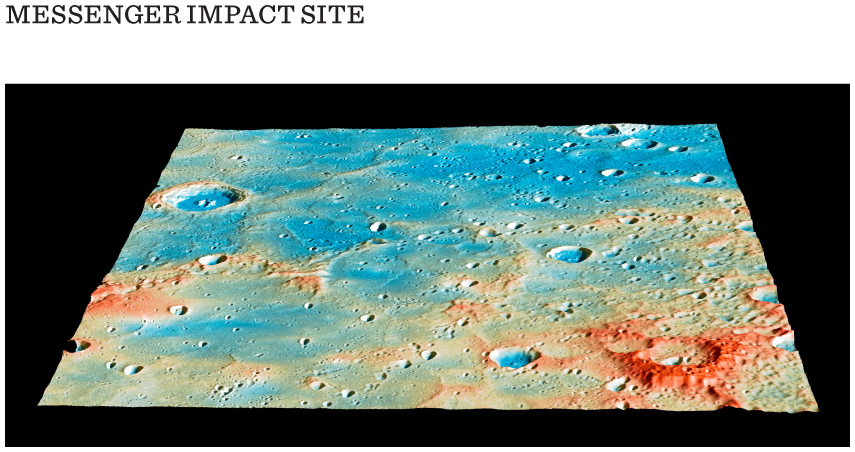
© NASA/Johns Hopkins University Applied Physics Laboratory/Carnegie Institution of Washington
On 30 April 2015, NASA added its own crater to this region of Mercury. At 3.26pm EDT, Messenger impacted the planet’s surface, bringing the spacecraft’s mission to a dramatic end, but leaving its mark forever with a crater estimated to be over 15 metres wide.
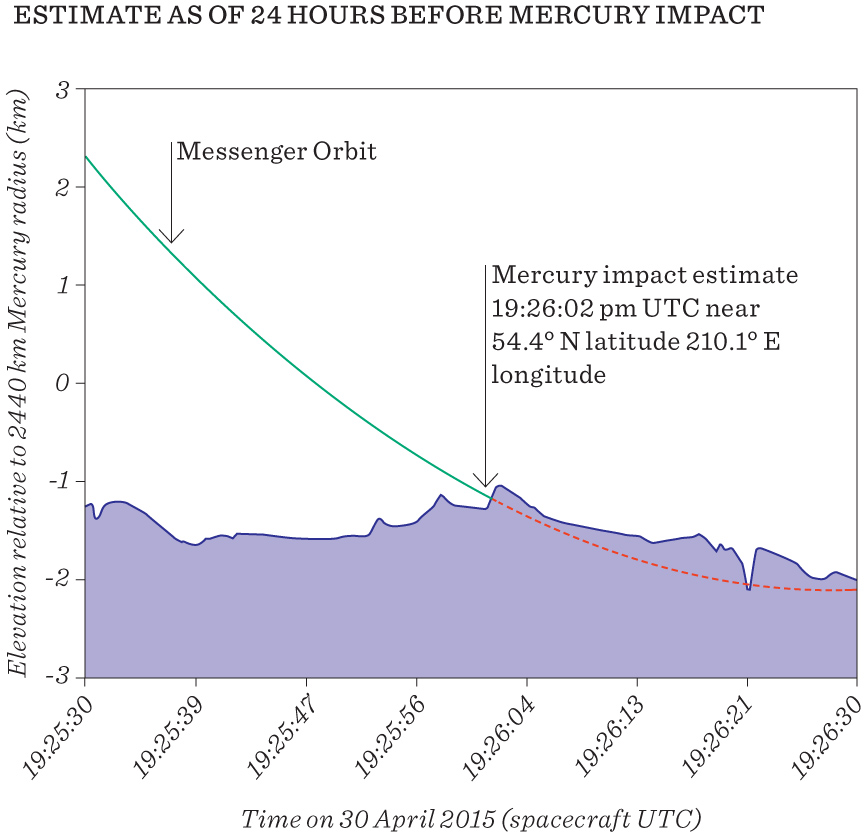
© redrawn from NASA/Johns Hopkins University Applied Physics Laboratory/Carnegie Institution of Washington
Four and a half billion years ago, we know that the inner Solar System was in turmoil. In the middle of it all, we think that the newly born Mercury found itself orbiting far out from today’s intimate proximity with the Sun, surrounded by rocky debris and scores of planetary embryos all jockeying for position. The young Solar System was still a place where planets could live or die. But it wasn’t just the rocky planets that found themselves disturbed; Jupiter, the largest and oldest of all the planets, was on the move, and when a planet of that size shifts its position there are almost always casualties. We’ll come back to the story of Jupiter’s grand tack and the havoc it spread throughout the Solar System in Chapter 3, but for now all we need to know is that the evidence suggests that the juvenile Mercury was kicked by the gravitational force of Jupiter on an inward trajectory, finding itself flung in towards the Sun and into the path of danger. In the crowded orbits of the early Solar System such a change of course was fraught with danger, and all of the evidence indicated that this was the most violent and defining of turns in Mercury’s history. As the planet swerved inwards it collided with another embryonic world and shattered.
Today we see the evidence of this ferocious collision in the strange structure of this tiny planet. A giant core has been left behind, the exposed interior of a planet that had much of its outer layer, its crust mantle, stripped away and lost to space in the aftermath of the collision. This collision not only transformed the physical characteristics of the planet but also knocked Mercury further inwards on a lopsided trajectory that we see reflected in the most elliptical orbit of all the planets. Although we cannot be certain of these events, it’s a brilliant piece of scientific deduction to use the evidence we have to create a plausible scenario of events that happened unimaginably long ago. Events that drove the first rock from the Sun from a position full of potential to a place much too close to the Sun to support any form of life; an opportunity lost. After four years of observation and its investigation of Mercury’s ancient past, Messenger finally ran out of fuel on 30 April 2015, and added yet another crater to this tortured world that once held such promise.

© NASA/Johns Hopkins University Applied Physics Laboratory/Carnegie Institution of Washington
In 1990, Voyager 1 captured a series of images from which we could create a portrait of the Solar System, giving a clear location for Mercury and its distance from Earth.
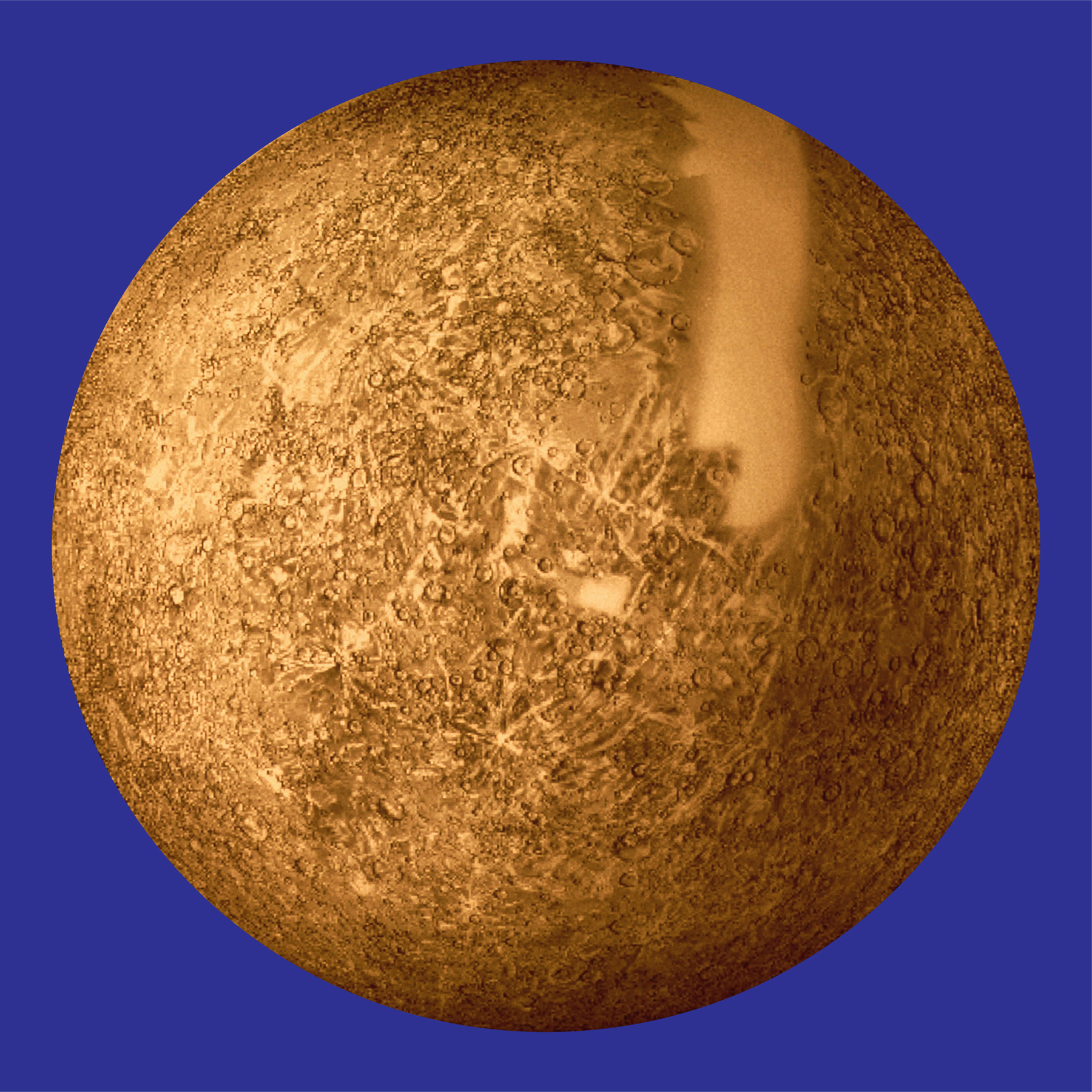
© US GEOLOGICAL SURVEY / SCIENCE PHOTO LIBRARY
Mariner 10 took the first close-up images of Mercury.
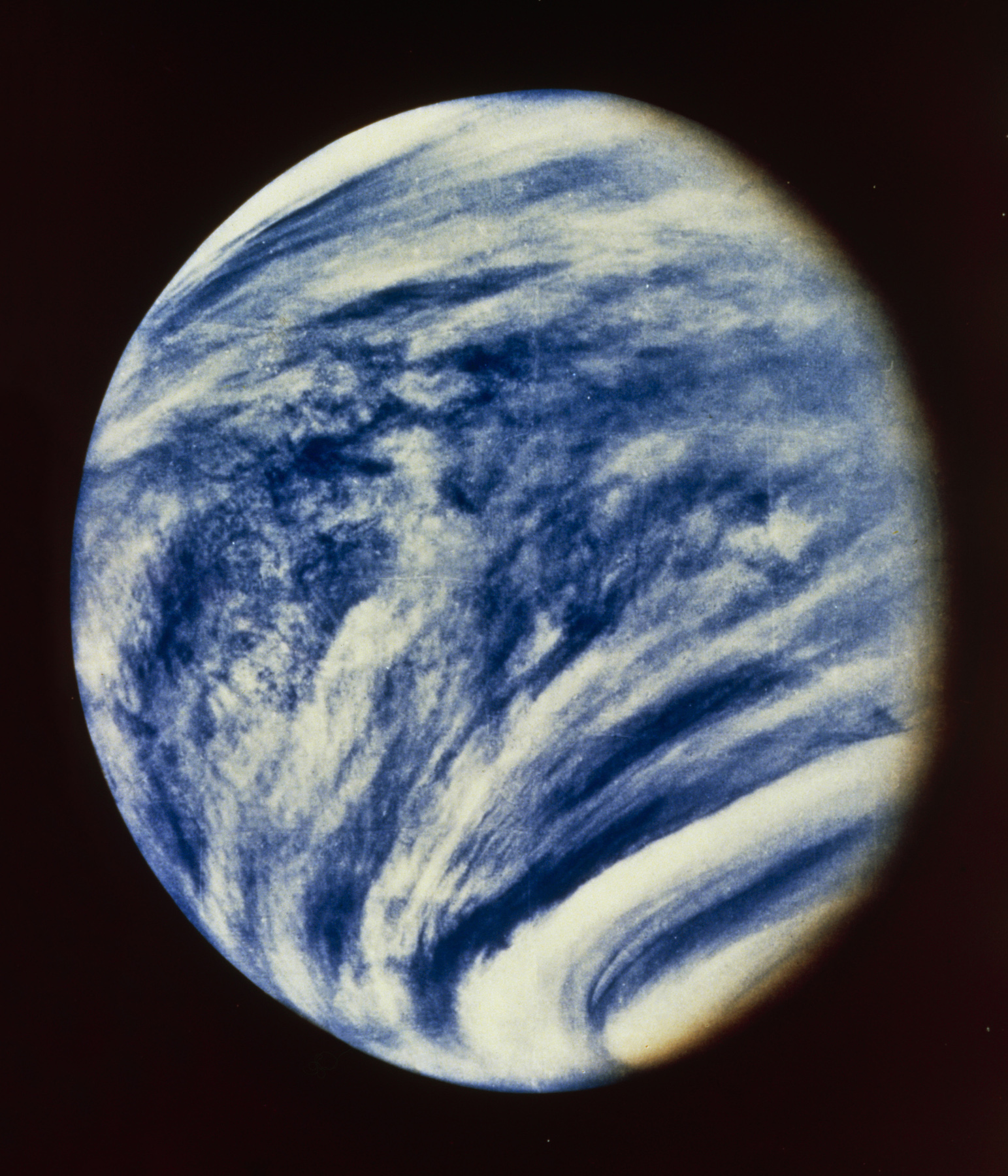
© NASA / SCIENCE PHOTO LIBRARY
Venus in the 1970s, which allowed scientists to compare the planets’ atmospheres.
PLANET OF MYSTERY
Shrouded in an unbroken blanket of cloud, the next rock from the Sun tells a very different story. Over 50 million kilometres beyond Mercury lies a world that at first sight has the potential to be far more Earth-like than her scorched inner companion.
Venus is perhaps the most mysterious of all the planets, lying on the inner edge of the so-called ‘habitable zone’; this is a planet that holds its secrets close. For centuries it has teased us with its brightness in the early morning and early evening sky. It’s so bright because it’s a large planet about the same size as the Earth, it’s not too far away from us either, and the clouds that shroud it are highly reflective, reflecting three-quarters of the light that hits them. That’s the frustrating but tantalising thing about Venus, because even when you look at it through a big telescope, it is featureless; you never see the surface, which means that until the 1950s scientists could only speculate about what lay beneath.
In the late nineteenth and early twentieth centuries many thought that beneath her clouds Venus was hiding a mirror world to Earth; if not home to complex, sentient life, then certainly hosting basic life forms. Faced with that impenetrable cloak, our collective imaginations fuelled the idea of a living, breathing world beneath the clouds, a shroud that meant for the first half of the twentieth century we lived convinced that we were far from alone in the Solar System.
‘I can find no reason … for denying that she may be considered the abode of creatures as far advanced in the scale of creation as any which exist upon the Earth.’
Richard Proctor, English astronomer, 1870
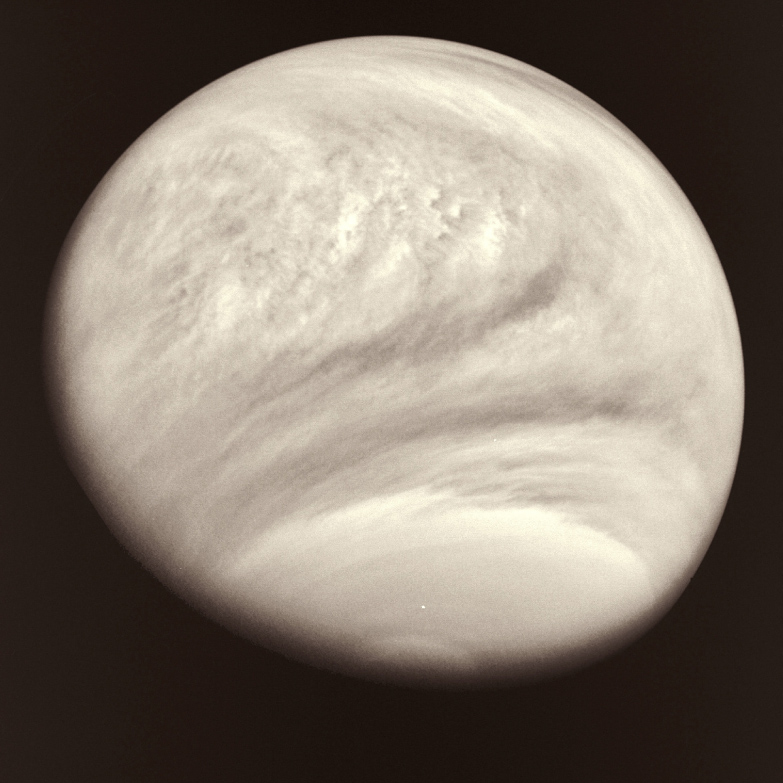
© NASA/ARC
A hazy and cloud-shrouded Venus, photographed by Pioneer Venus Orbiter.
Nobel Prize-winning chemist Svante Arrhenius was one of the most renowned scientists to fuel the mythology of what lurked behind Venus’s cover. Like many of the scientists of his era, Arrhenius let his curiosity wander into many different realms, including astronomy, and he hypothesised at length about the Venusian environment. Assuming the clouds of Venus were composed of water, he wrote in his book The Destinies of the Stars that ‘a very great part of the surface of Venus is no doubt covered with swamps’, creating an environment not unlike the tropical rainforests found here on Earth.
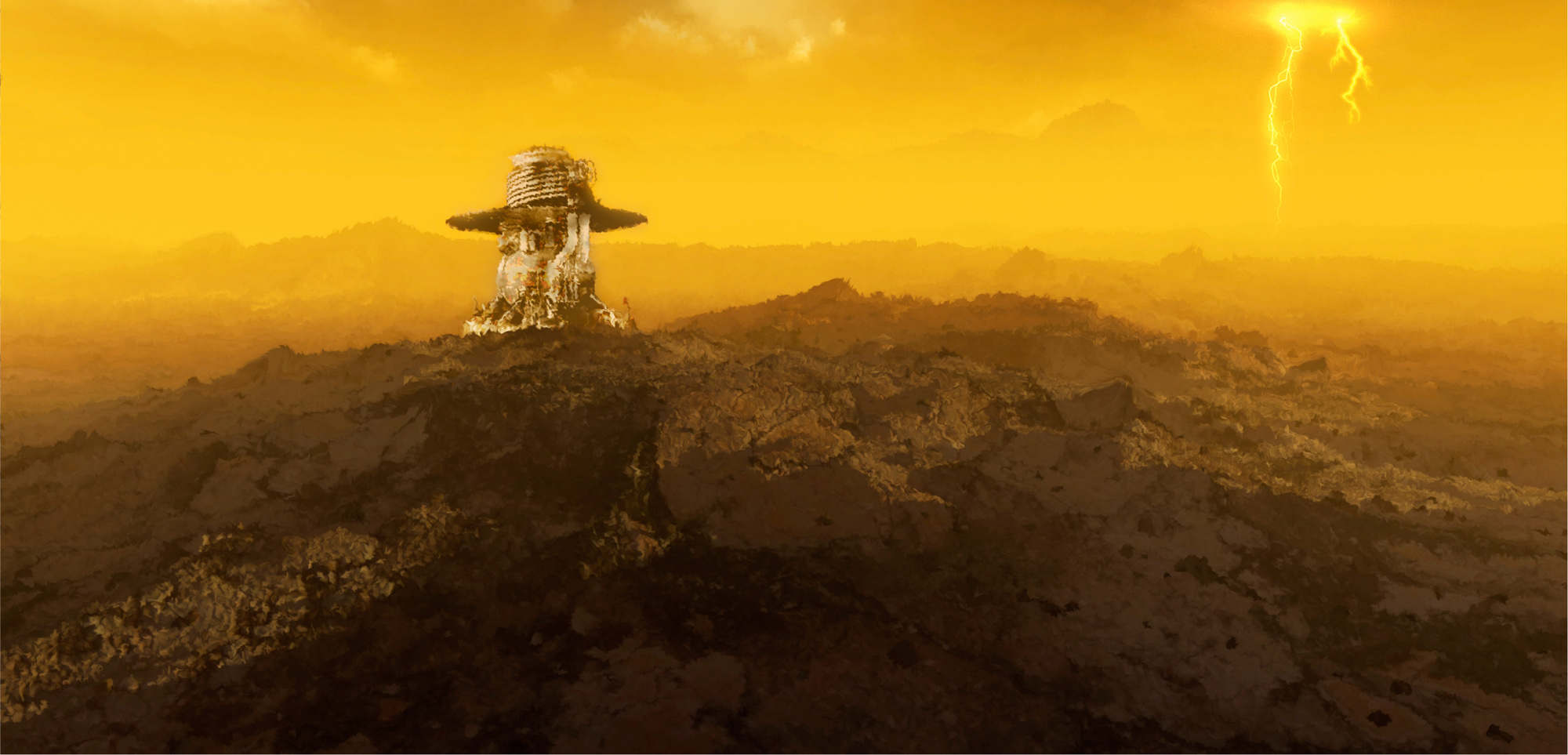
© MARK GARLICK / SCIENCE PHOTO LIBRARY
Artwork showing the successful landing of the Venera 9 spacecraft, which in its 53 minutes on the surface of Venus returned the first ever images of the planet.
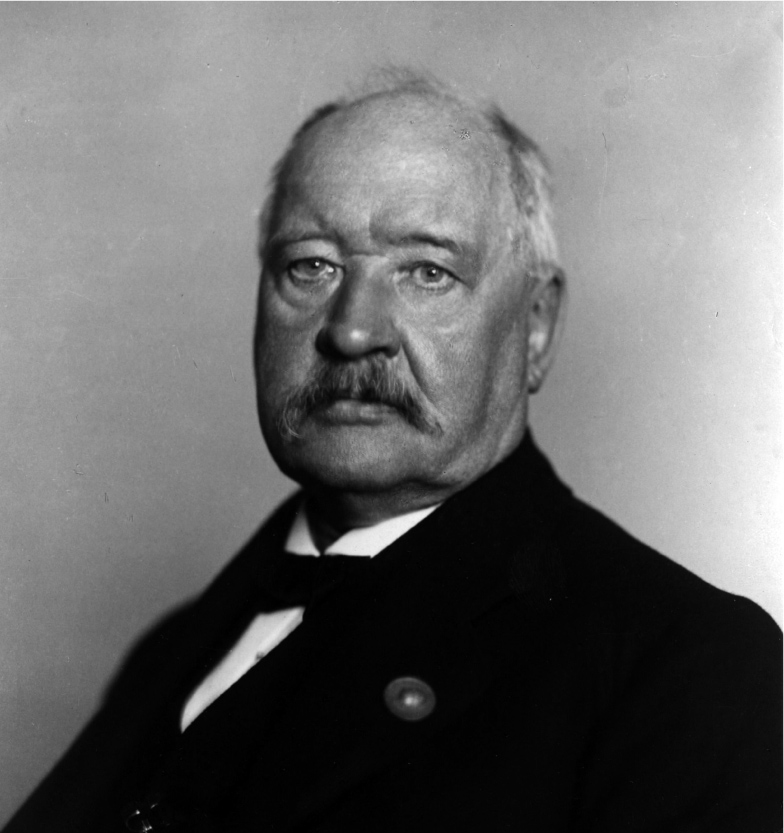
© Science History Images / Alamy Stock Photo
Svante Arrhenius, Nobel Prize-winning chemist
‘Everything on Venus is dripping wet … A very great part of the surface … is no doubt covered with swamps corresponding to those on the Earth in which the coal deposits were formed … The constantly uniform climatic conditions which exist everywhere result in an entire absence of adaptation to changing exterior conditions. Only low forms of life are therefore represented, mostly no doubt belonging to the vegetable kingdom; and the organisms are nearly of the same kind all over the planet.’
Expanding on this picture, he suggested that the complete cloud cover of the planet created a uniformity totally unlike the extremes of weather that define different parts of the Earth. In Arrhenius’s imagination this stable environment, with a consistently uniform climate all over the planet, meant that any life on Venus lived without the evolutionary pressures of changing environments that drive natural selection here on Earth, leaving Venus in an evolutionary limbo akin to the Carboniferous Period. Describing a world full of prehistoric swamps and dank forests, Arrhenius created the perfect canvas for science-fiction writers of the time to conjure up a menagerie of curious life forms lurking beneath the clouds.
Today Arrhenius is far less known for his fertile imaginings on the wildlife of Venus than he is for his work on the climate of Earth. In 1896 he was the first scientist to use basic principles of chemistry to demonstrate the impact that the atmosphere can have, in particular levels of carbon dioxide, on the surface temperature, a process that was called the Arrhenius effect but is now known as the greenhouse effect. An effect that would not only have profound consequences for our understanding of our impact on our own planet, but would also be vital in explaining the true nature of Venus beneath the clouds.
By the 1920s, as ground-based technology improved, we stopped painting the surface of Venus with our imaginations and started filling in the gaps with facts. The first spectroscopic analysis of the planet’s atmosphere suggested that it wasn’t water or oxygen that filled the clouds of Venus, so some thought this hinted at an arid, desert land beneath. Others speculated that formaldehyde filled the air, leading to the belief that Venus was not only a dead planet but a pickled one, too. But come the 1950s the true nature of Venus began to be revealed, as more accurate Earth-based observation suggested the presence of overwhelming levels of one defining gas in the Venusian atmosphere. This was not a planet shrouded in clouds of water and oxygen, nor pickled in formaldehyde, this was a planet engulfed in a blanket of carbon dioxide, and as Arrhenius had demonstrated on Earth, this almost certainly meant that whatever lay beneath the clouds, the heat would be beyond the limits of even the most resilient life forms on Earth. As the first spacecraft were being built to explore our sister world, it was becoming increasingly clear that visiting Venus would be far from easy and she would be far from welcoming.

